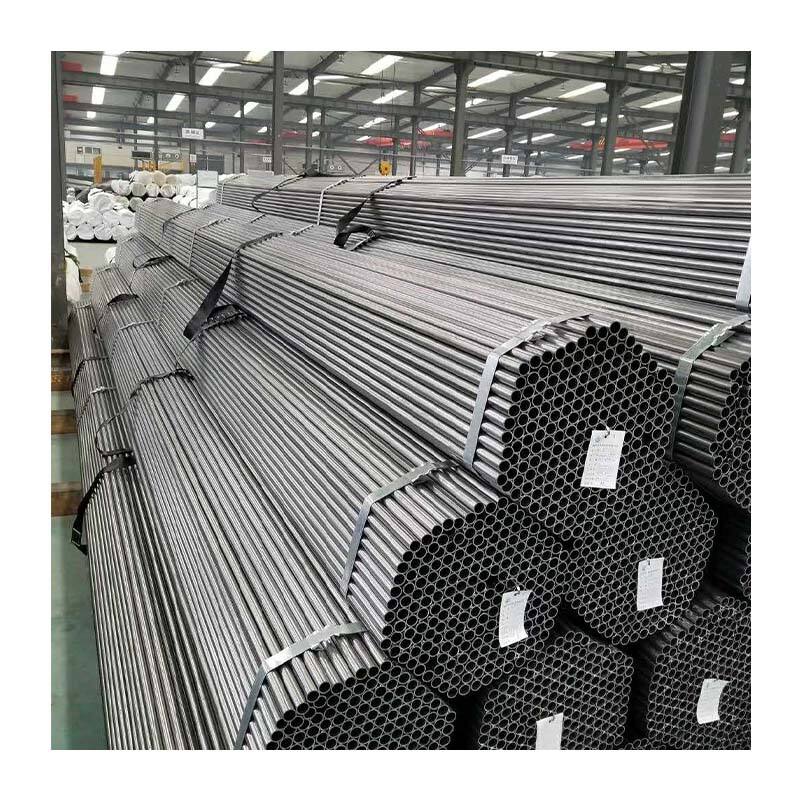What Are Galvanized Pipes? Understanding Structure and Galvanization Process
Definition and Manufacturing: How Steel Pipes Are Galvanized With Zinc
Galvanized pipes basically consist of steel tubing covered in a protective zinc coating, achieved either through hot-dip galvanization or electroplating techniques. When manufacturers use the hot-dip method, they first clean the steel pipes thoroughly before submerging them into molten zinc heated around 450 degrees Celsius (or about 842 Fahrenheit). This creates a strong bond between the metals, resulting in a zinc-iron alloy layer roughly 0.002 inches thick. For situations requiring finer control, electroplating comes into play where electric currents deposit much thinner zinc layers measuring between 0.0002 to 0.0005 inches thick. While both approaches serve the same fundamental purpose of protecting steel from corrosion and rust, engineers often choose one method over another based on specific project requirements and budget constraints.
Key Physical and Chemical Properties of Galvanized Pipe
Galvanized pipes typically have a yield strength between 30,000 and 50,000 psi, with thermal expansion rates around 11.7 times 10 to the negative sixth power per degree Fahrenheit. The zinc layer helps maintain stable pH levels in water systems when the range stays between 6.5 and 12.5. But watch out what happens when conditions change. Corrosion speeds up dramatically about four times faster in acidic environments below pH 6 or where chloride content goes over 500 parts per million. Steel itself has a standard density of 7.85 grams per cubic centimeter, but once it gets galvanized, the surface hardness comes in at approximately 179 diamond pyramid hardness units. This gives the material good resistance without making it too difficult to work with during manufacturing processes.
How the Zinc Coating Prevents Corrosion in Plumbing Environments
Zinc coatings work in two main ways: they sacrifice themselves first when corrosion starts, and they create a protective barrier against further damage. When dealing with acidic water below pH 7, zinc tends to wear away much slower than steel does. Steel typically loses around 0.12 mm per year while zinc only corrodes about 0.02 mm annually under similar conditions. This protective effect lasts until roughly 70% of the zinc coating has been consumed. Things change in alkaline environments where something interesting happens. Zinc reacts with carbon dioxide in the air to form zinc carbonate (ZnCO3), creating what we call a patina on the surface. This layer is basically waterproof and stops oxygen from getting through to the metal underneath. Real world testing indicates these combined protective effects can keep pipes working for anywhere between 40 to 60 years in normal climate zones. However, near coastlines where saltwater gets involved, the same protection only lasts about half as long because salt accelerates the breakdown process significantly.
Advantages of Galvanized Steel Pipes in Plumbing Applications
High Durability and Resistance to Mechanical Stress and Pressure
Galvanized pipes excel in structural resilience due to their zinc-coated steel construction. They withstand pressures up to 150 PSI, making them suitable for high-stress plumbing systems. Properly installed systems maintain integrity for 40–70 years, outperforming many non-metallic alternatives in environments with temperature fluctuations or ground movement.
Cost-Effectiveness: Low Initial Cost vs. Long-Term Value
With material costs averaging $2–$5 per linear foot, galvanized pipes offer a budget-friendly option compared to copper ($8–$12/ft). While mineral buildup may require maintenance after 15–20 years, their upfront affordability and 50-year corrosion resistance—when the zinc layer remains intact—justify use in low-risk residential or agricultural water systems.
Performance in Hard Water Areas: Myth or Real Benefit?
Galvanized pipes won't fix hard water problems, but those thick walls do stand up better against scaling that causes pressure loss compared to copper when dealing with mineral-heavy water supplies. Some independent testing showed older galvanized pipe systems still kept about 85% of their original flow capacity, while copper pipes dropped down to around 8% functionality after sitting in hard water for a decade. They work okay for temporary fixes and definitely show some real advantages there. Still, if looking at longer term options, materials like PVC just perform better overall when it comes to handling minerals over time.
Disadvantages and Risks of Using Galvanized Pipes Over Time
Internal Mineral Buildup and Reduced Water Flow in Aging Systems
When the protective zinc layer starts wearing away, the steel underneath begins to corrode and react with minerals in the water over time. After somewhere between 15 to 30 years, stuff like rust (iron oxide) and lime deposits (calcium carbonate) build up inside pipes, sometimes shrinking their inner diameter by half in really bad situations. According to research published last year on plumbing systems, older galvanized pipes from around 40 years ago showed a drop in water flow of about 34%. People living in homes with these old pipes typically notice lower water pressure at faucets, inconsistent water distribution across different fixtures in the house, and can even hear gritty particles moving around when they turn on a tap.
Health and Water Quality Concerns: Rust, Lead, and Sediment Contamination
Corroded galvanized pipes introduce three primary contaminants:
- Iron oxides: Cause reddish-brown discoloration and metallic-tasting water
- Lead particles: Released as zinc degrades, especially in homes built before 1986 where lead solder was used (CDC notes 10–20% of U.S. homes with galvanized plumbing exceed EPA lead action levels)
- Biofilm colonies: Develop in rough, mineral-laden interiors, promoting bacterial growth
Galvanized systems can act as "lead sponges," absorbing lead from historical solder joints or municipal lines and releasing it during flow changes. Water testing in pre-1970 homes shows 3–8 higher lead concentrations when these pipes remain in service.
Maintenance Difficulties and Replacement Challenges Due to Corrosion and Threading
Retrofitting galvanized plumbing often requires full system replacement rather than spot repairs. Key complications include:
| Challenge | Impact |
|---|---|
| Frozen threaded joints | 68% of professional plumbers report seized connections requiring pipe section demolition |
| Brittle walls | Aged pipes crack during disassembly, spreading debris through valves and appliances |
| Mixed-material systems | Mandatory dielectric unions to prevent galvanic corrosion with copper/PVC add 25–40% to project costs |
Municipal inspectors increasingly flag galvanized systems for complete removal—a 2025 International Plumbing Code update restricts their use in potable water line repairs.
Galvanized Pipe vs. Copper, PEX, and PVC: A Practical Comparison
Performance Comparison: Corrosion Resistance, Flexibility, and Thermal Stability
Galvanized pipes are pretty sturdy but just don't hold up well over time. The zinc coating does protect them at first, but when it comes to resisting corrosion especially in areas with acidic water, materials like PVC and PEX simply perform better. Copper can handle temperatures above 200 degrees Fahrenheit without issues, whereas galvanized steel starts losing its protective zinc layer once temps hit around 140 degrees. Speaking of earthquakes, PEX piping has become popular because its flexible nature cuts down on joint failures by roughly three quarters compared to those old fashioned rigid galvanized pipes. This was actually highlighted in the Plumbing Safety Standards report from last year.
Material and Lifecycle Costs: Galvanized vs. Modern Alternatives
| Material | Average Lifespan | Installation Cost (per linear foot) | Maintenance Cost (10-year cycle) |
|---|---|---|---|
| Galvanized | 25–40 years | $8.50 | $1,200 |
| Copper | 50+ years | $12.00 | $400 |
| PEX | 40–50 years | $6.80 | $150 |
| PVC | 25–35 years | $5.20 | $90 |
Despite lower initial material costs, galvanized pipes incur higher maintenance and earlier replacement needs, increasing total ownership costs by 15–20% over 30 years compared to PEX.
Galvanic Corrosion Risk When Connecting Galvanized and Copper Pipes
Combining these materials accelerates corrosion at connection points due to electrochemical incompatibility. A 2022 field survey found 63% of mixed-material systems developed leaks within 8 years, versus 12% for homogeneous PEX installations. Dielectric unions can delay—but not eliminate—this risk, requiring biannual inspections in hybrid systems.
Real-World Example: Replacing Galvanized Pipes With PEX in Older Homes
A 1950s Seattle home retrofit demonstrated PEX’s advantages:
- Water pressure increased from 35 psi to 62 psi post-replacement
- Installation time dropped by 60% using push-to-connect fittings
- Annual pipe-related repairs fell from $870 to $40
This reflects industry trends showing 81% of plumbers now recommend PEX for galvanized pipe replacements (2023 Plumbing Materials Report).
How to Choose the Right Pipe Material Based on Code, Environment, and Use Case
Evaluating Water Hardness, Climate, and Household Demand for Optimal Performance
Galvanized pipes work really well in areas with gentle weather and soft water since their zinc coating stands up pretty good against rusting. But when we get into places with hard water content above around 180 parts per million calcium carbonate, things start going downhill fast. The minerals build up inside these pipes much quicker, which means water flow gets restricted quite a bit after about ten years running through them - somewhere between 25% and 40% less flow actually. If winter temperatures regularly drop below freezing point, then PEX tubing becomes a smarter choice because it handles those extreme temperature changes far better than old fashioned galvanized steel ever could. And for homes that run through lots of water daily, especially those with three bathrooms or more, it makes sense to go with piping materials rated for pressures over 80 pounds per square inch. Otherwise all those connections will eventually leak out, causing headaches down the road.
Understanding Local Plumbing Codes and Restrictions on Galvanized Pipe Use
Most states across the country have banned galvanized pipes from new drinking water installations because they can rust and leach lead into the water supply. Take California as an example the state updated its plumbing regulations in 2023 to require either copper or PEX piping for home renovations, though galvanized steel is still allowed but only for natural gas applications. Before tearing out old plumbing systems, it's smart to check what local authorities say about replacements. Some areas actually permit limited use of galvanized pipes when the remaining zinc coating measures at least 85 micrometers thick, which helps maintain structural integrity without compromising water quality.
Matching Pipe Material to System Age, Pressure Requirements, and Retrofit Needs
Homes built before 1970 that still have galvanized plumbing usually need complete replacement because the inside diameter gets smaller over time as corrosion sets in. When doing retrofits, PEX piping stands out for its flexibility, making it possible to snake through existing walls without tearing down structures or cutting big holes. This is a real advantage compared to older rigid materials like galvanized or copper pipes that can be a nightmare to work with. For situations where pressure exceeds normal levels, schedule 80 PVC actually holds up better against bursts than those old galvanized steel lines. Still worth checking local codes though since requirements vary quite a bit from one area to another.
Frequently Asked Questions (FAQ)
What are galvanized pipes made of?
Galvanized pipes consist of steel tubing coated with a protective layer of zinc to prevent corrosion.
How long do galvanized pipes last?
Galvanized pipes can last between 40 and 60 years in normal climate zones, although this lifespan may be reduced in coastal areas.
Why are galvanized pipes no longer recommended for drinking water?
Galvanized pipes can rust and leach lead into the water supply, leading to health concerns and various regulations banning their use in new drinking water installations.
How does zinc coating protect galvanized pipes?
Zinc coating acts as a sacrificial layer that corrodes slowly, forming a protective barrier that prevents corrosion of the underlying steel.
What alternatives are recommended for replacing galvanized pipes?
Copper, PEX, and PVC are commonly recommended alternatives due to their better performance, corrosion resistance, and flexibility.
Table of Contents
- What Are Galvanized Pipes? Understanding Structure and Galvanization Process
- Advantages of Galvanized Steel Pipes in Plumbing Applications
- Disadvantages and Risks of Using Galvanized Pipes Over Time
- Galvanized Pipe vs. Copper, PEX, and PVC: A Practical Comparison
- How to Choose the Right Pipe Material Based on Code, Environment, and Use Case
- Frequently Asked Questions (FAQ)

